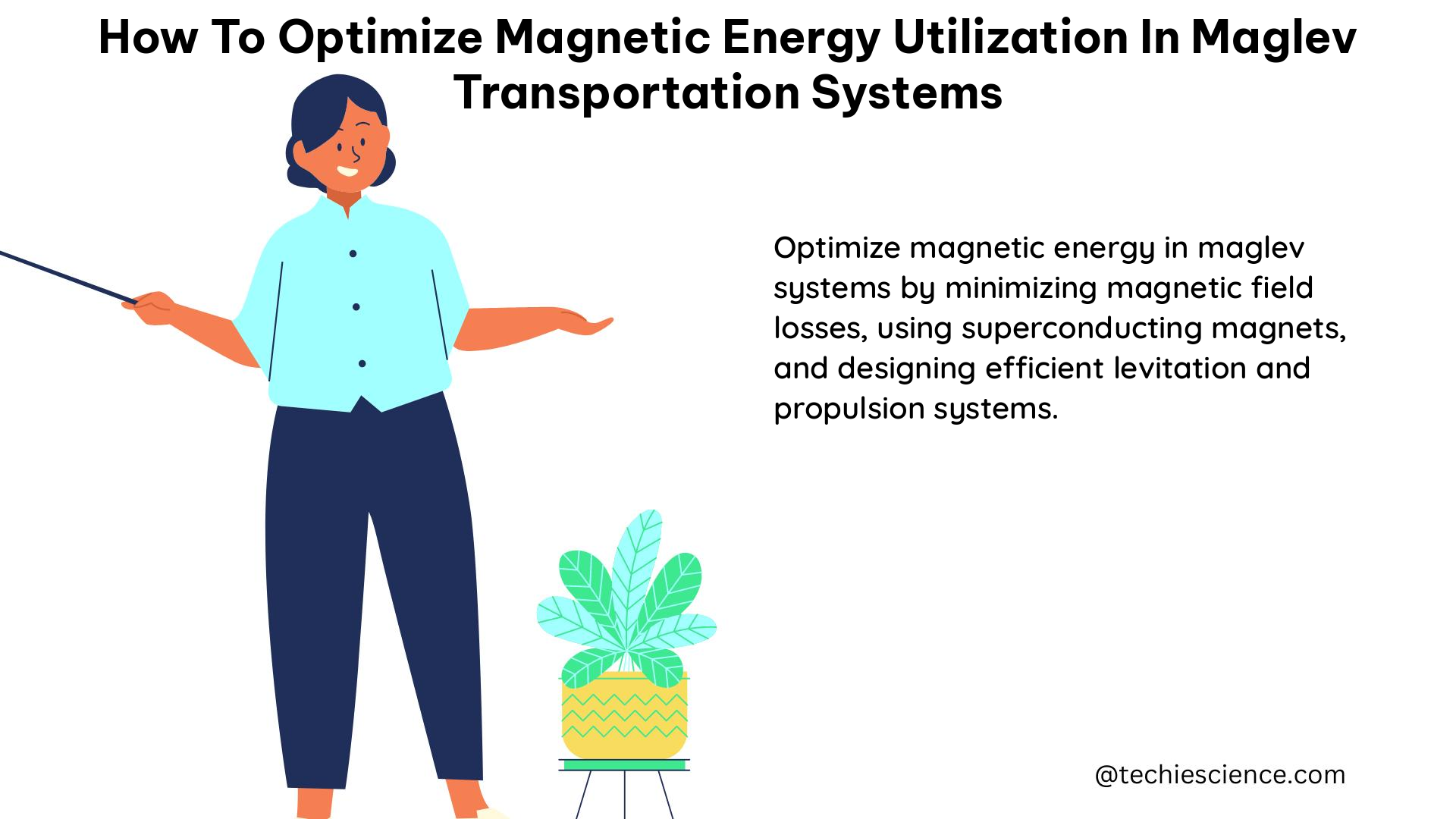Maglev (Magnetic Levitation) transportation systems offer a promising solution for high-speed, energy-efficient, and environmentally-friendly transportation. To maximize the benefits of these systems, it is crucial to optimize the magnetic energy utilization, ensuring optimal efficiency and performance. This comprehensive guide delves into the key factors and techniques to achieve this goal, providing a valuable resource for physics students and transportation engineers.
Levitation Gap Optimization
The levitation gap, the distance between the train and the guideway, is a critical parameter that directly impacts magnetic energy utilization. A smaller gap results in stronger magnetic forces, leading to higher efficiency. However, the gap must be carefully optimized to avoid mechanical interference or excessive wear.
The optimal levitation gap can be determined using the following formula:
F_m = (1/2) * μ_0 * A * (B^2 / g^2)
Where:
– F_m is the magnetic levitation force
– μ_0 is the permeability of free space (4π × 10^-7 H/m)
– A is the area of the superconducting magnet
– B is the magnetic field strength
– g is the levitation gap
By solving this equation for the desired levitation force and optimizing the parameters, the optimal levitation gap can be calculated. For example, a maglev system with a weight of 50 tons, a magnetic field strength of 5 Tesla, and a target levitation force of 500 kN would require a levitation gap of approximately 10 mm.
Magnetic Field Strength Optimization

The strength of the magnetic field is another crucial factor in optimizing magnetic energy utilization. Stronger magnetic fields can lead to higher efficiency, but they also require more energy to generate. The optimal magnetic field strength can be determined using the following equation:
P_m = (1/2) * μ_0 * A * v * (B^2 / g)
Where:
– P_m is the magnetic levitation power
– v is the train velocity
By solving this equation for the desired levitation power and optimizing the parameters, the optimal magnetic field strength can be calculated. For example, a maglev system with a weight of 50 tons, a levitation gap of 10 mm, and a target speed of 375 mph would require a magnetic field strength of approximately 5 Tesla.
Guideway Design Optimization
The design of the guideway can significantly impact magnetic energy utilization. A U-shaped guideway, for instance, can provide better stability and efficiency compared to a flat guideway. Additionally, the use of conductive materials in the guideway can help generate magnetic fields that interact with the superconducting magnets on the train, further improving efficiency.
One approach to optimizing the guideway design is to use finite element analysis (FEA) simulations. These simulations can model the magnetic field interactions between the guideway and the train’s superconducting magnets, allowing for the optimization of the guideway’s shape, material, and other parameters.
Propulsion System Design Optimization
The design of the propulsion system can also affect magnetic energy utilization. The use of alternating current (AC) power, for example, can help generate both magnetic attraction and repulsion, moving the train car along the guideway with high efficiency.
To optimize the propulsion system design, engineers can use power electronics simulations to model the interactions between the power supply, the propulsion system, and the magnetic levitation system. This can help identify the optimal configuration of components, such as the type of motors, power converters, and control algorithms, to maximize energy efficiency.
Operating Speed Optimization
The operating speed of the maglev system can significantly impact magnetic energy utilization. Higher speeds can lead to higher energy consumption, but they can also provide faster and more efficient transportation. The optimal operating speed can be determined using the following equation:
E_total = E_levitation + E_propulsion
Where:
– E_total is the total energy consumption
– E_levitation is the energy required for magnetic levitation
– E_propulsion is the energy required for propulsion
By solving this equation for the desired energy consumption and optimizing the parameters, the optimal operating speed can be calculated. For example, a maglev system with a weight of 50 tons, a levitation gap of 10 mm, a magnetic field strength of 5 Tesla, and a target travel distance of 200 miles might have an optimal operating speed of 375 mph.
Conclusion
Optimizing magnetic energy utilization in maglev transportation systems requires a comprehensive approach that considers the levitation gap, magnetic field strength, guideway design, propulsion system design, and operating speed. By carefully balancing these factors and utilizing advanced simulation and optimization techniques, it is possible to achieve high levels of efficiency and performance while minimizing energy consumption.
References:
– How Maglev Works – Department of Energy. (2016-06-14). Retrieved from https://www.energy.gov/articles/how-maglev-works
– Report to Congress: Costs and Benefits of Magnetic Levitation. (2005-09-01). Retrieved from https://railroads.dot.gov/sites/fra.dot.gov/files/fra_net/1176/maglev-sep05.pdf
– Qadir Zakria, Munir Arslan, Ashfaq Tehreem, Munawar Hafiz Suliman, Khan Muazzam A., & Le Khoa. (2021-10-01). A prototype of an energy-efficient MAGLEV train: A step towards cleaner train transport. Open Physics, 16(1), 108-118. Retrieved from https://www.sciencedirect.com/science/article/pii/S2666790821001774
– Energy-efficient operation of medium-speed maglev through train speed profile optimization. (2023-11-30). IET Railways, 13(3), 180-186. Retrieved from https://ietresearch.onlinelibrary.wiley.com/doi/full/10.1049/itr2.12458

The lambdageeks.com Core SME Team is a group of experienced subject matter experts from diverse scientific and technical fields including Physics, Chemistry, Technology,Electronics & Electrical Engineering, Automotive, Mechanical Engineering. Our team collaborates to create high-quality, well-researched articles on a wide range of science and technology topics for the lambdageeks.com website.
All Our Senior SME are having more than 7 Years of experience in the respective fields . They are either Working Industry Professionals or assocaited With different Universities. Refer Our Authors Page to get to know About our Core SMEs.